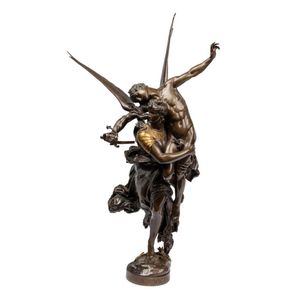"Gloria Victis" by Mercie: Symbolic French Patriotism in Bronze
Marius Jean Antonin Mercie (French 1845 - 1916), Gloria Victis, circa 1889, conceived circa 1874, the gilded and patinated bronze with a circular plinth base signed 'A. Mercie', titled 'Gloria Victis', with foundry inscription 'F. Barbedienne, Fondeur' and with 'A. Collas Reduction Mechanique' cachet stamp, 82.5 cm high. Other Notes: the full-size plaster model of Gloria Victis was exhibited at the salon of 1874, winning the Medaille d'Honneur and critical acclaim. It was then purchased by the city of Paris for the sum of twelve thousand francs and then cast in bronze by Victor Thiebaut for eight thousand francs. The original bronze is now placed in a central courtyard at the Hotel de Ville. The plaster version was re-exhibited at the Paris Exposition Universelle of 1878, alongside bronze reductions of the group by Barbedienne. Mercie's modern sculpture had become an instant classic, even receiving an entry in the Nouveau Larousse Illustre. The success of the group undoubtedly lay in the fact that it was admired not just on an aesthetic level, but also on a patriotic level. The winged female figure of hope carries to glory a dying French hero, his broken sword a sign of defeat. As the sting of their defeat at the hands of the Prussians was still keenly felt by the French nation, the idea of commemoration of heroism in defeat made Mercie's composition especially popular. Critics also marvelled at the compositional daring of the group, balancing as it did two figures on the minimal support of one foot.
You must be a subscriber, and be logged in to view price and dealer details.
Subscribe Now to view actual auction price for this item
When you subscribe, you have the option of setting the currency in which to display prices to $Au, $US, $NZ or Stg.
This item has been sold, and the description, image and price are for reference purposes only.
- Composition - Composition is a material used for dolls, sculpture and furniture. It is a type of composite material made from a mixture of materials such as sawdust, glue, and pigments. It is a popular material for dolls and figurines because it is lightweight and easy to work with. It is also used in furniture-making, particularly in the construction of decorative pieces such as figurines and sculptures. It is less common in high-end furniture as it is not as durable as some other materials such as wood or metal. However, it is a more affordable and accessible option for some types of decorative pieces.
- Gilding - Gilding is a method of ornamentation whereby a thin sheet of gold metal is applied to items made of wood, leather, ceramics, glass and silver for decorative purposes.
For furniture including mirrors, the sheet of gold is usually applied over a coating of gesso. Gesso is a mixture of plaster of Paris and gypsum mixed with water and then applied to the carved wooden frames of mirrors and picture frames as a base for applying the gold leaf. After numerous coats of gesso have been applied, allowed to dry and then sanded a coat of "bole", a usually red coloured mixture of clay and glue is brushed on and allowed to dry, after which the gold leaf is applied. Over time parts of the gilding will rub off so the base colour can be seen. In water gilding, this was generally a blue colour, while in oil gilding, the under layer was often yellow. In Victorian times, gilders frequently used red as a pigment beneath the gold leaf.
Metal was often gilded by a process known as fire gilding. Gold mixed with mercury was applied and heated, causing the mercury to evaporate, the long-term effect of which was to kill or disable the craftsman or woman from mercury poisoning. The pursuit of beauty has claimed many victims, not the least of which were the artists who made those pieces so highly sought after today. - "reduction Mecanique A. Collas Brevete" - "Reduction Mecanique A. Collas Brevete" stamped onto a raised disk on a statue translates as "Mechanical Reduction, A. Collas Patent", referring to the patented method used to reduce the sculptures from their original size. Achille Collas (1795?1859) was a French engineer, inventor, writer and engraver who in 1836 developed a pantograph style machine which enabled him to reduce sculptures to a smaller scale. In 1838, he started a company together with Ferdinand Barbedienne, who was experienced in foundry techniques, to produce reduced copies of sculptures in materials including plaster, wood, bronze and ivory. Following the Great Exhibition of 1851 in London where the company received a special medal, and the Exposition Universelle in Paris when Collas was awarded the Grand Médaille d'Honneur the sculptures became increasingly popular and by 1892 had over 600 employees. The company, Société Collas et Barbedienne continued in production until 1954.
- Bronze - An alloy of copper and tin, traditionally in the proportions of about 9 parts of copper to 1 part of tin.
The discovery of bronze in Western Asia in the 4th century enabled people to create metal objects which were superior to those previoulsy possible because of its strength and hardness, and it has been used throughout the world for weapons, coins, tools, statuary and other decorative items.
It is very fluid in a molten state, and its hardness, strength when set, and non-corrosive properties makes it most suitable for casting sculpture. - Circa - A Latin term meaning 'about', often used in the antique trade to give an approximate date for the piece, usually considered to be five years on either side of the circa year. Thus, circa 1900 means the piece was made about 1900, probably between 1895 and 1905. The expression is sometimes abbreviated to c.1900.
This item has been included into following indexes:
